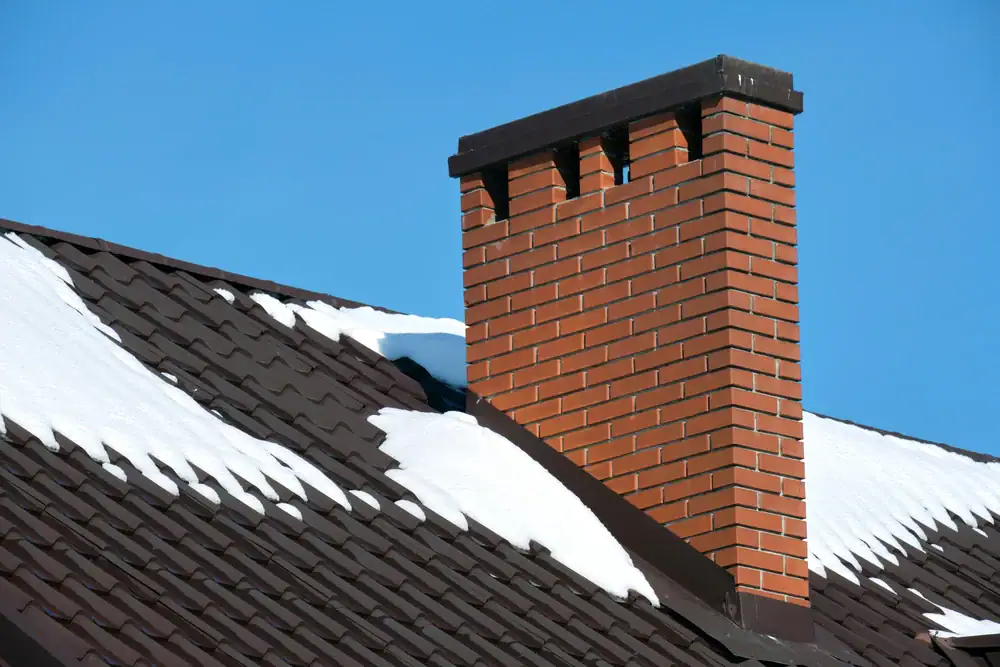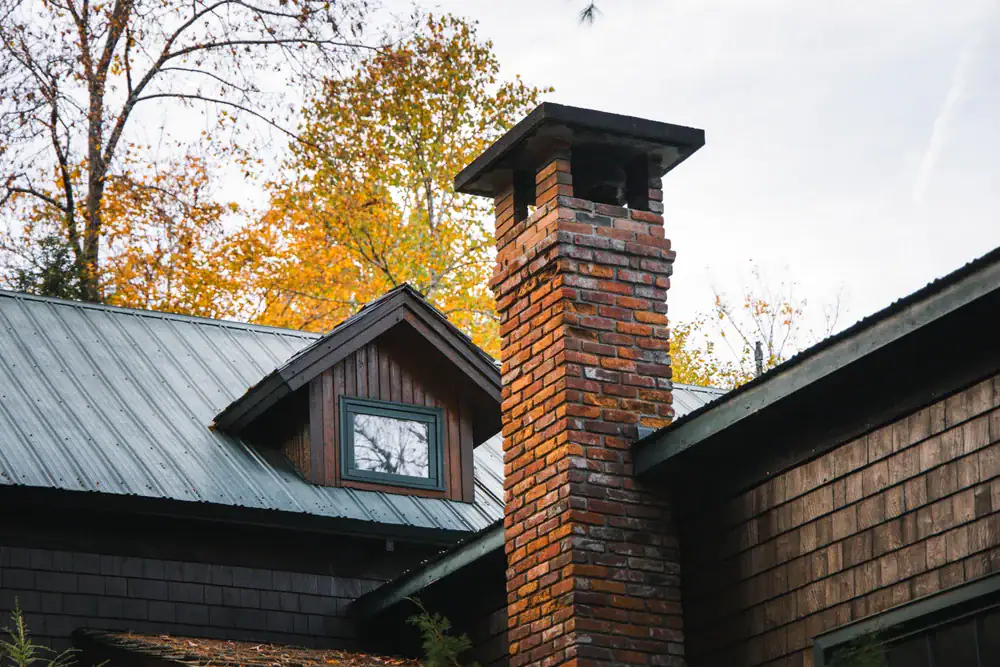Summary:
Early Warning Signs of Chimney Damage
The most telling signs of chimney trouble often appear long before you notice smoke backing up into your house or water dripping down your walls. These early indicators are your chance to address problems while they’re still manageable and affordable.
White, chalky staining on your chimney’s exterior bricks is one of the most common early warnings. This efflorescence might look harmless, but it’s actually telling you that water is penetrating your masonry. In Minnesota’s climate, this is a serious red flag that your chimney’s waterproofing is failing.
Take a close look at the mortar between your bricks too. Cracks, gaps, or crumbling mortar signal structural issues that will only get worse with each freeze-thaw cycle we experience here in Scott County, Hennepin County, and throughout the Twin Cities, MN.
What White Staining Really Means for Your Chimney
That white, powdery residue appearing on your chimney bricks isn’t just cosmetic. Efflorescence is essentially your chimney crying for help. When water penetrates the masonry, it dissolves salts within the brick and mortar. As the water evaporates, these salts are left behind on the surface, creating those telltale white stains.
Here’s why this matters in Minnesota. Once water gets into your masonry, our freeze-thaw cycles become a destructive force. Water expands when it freezes, creating pressure that cracks and weakens your chimney from the inside out. What starts as minor water penetration quickly becomes structural damage that compromises your entire chimney system.
The presence of efflorescence indicates your chimney’s waterproofing has failed completely. This isn’t something that gets better on its own. Without proper chimney repair, you’re looking at accelerated deterioration that can affect not just your chimney, but the surrounding areas of your home where the chimney connects to your roof and interior walls.
If you’re seeing white staining, especially after our wet spring seasons or heavy snow melts common in Dakota County, MN and Ramsey County, MN, it’s time to have a professional chimney inspection. The longer you wait, the more extensive and expensive the repairs become. What might be a relatively simple waterproofing treatment today could become a major reconstruction project next year.
Minnesota homeowners often underestimate how quickly this damage progresses. The National Fire Protection Association recommends annual chimney inspections for good reason. Catching efflorescence early can save you thousands in repair costs and protect your family from the safety hazards that come with compromised chimney systems.
Mortar Problems That Signal Bigger Issues
That white, powdery residue appearing on your chimney bricks isn’t just cosmetic. Efflorescence is essentially your chimney crying for help. When water penetrates the masonry, it dissolves salts within the brick and mortar. As the water evaporates, these salts are left behind on the surface, creating those telltale white stains.
Here’s why this matters in Minnesota. Once water gets into your masonry, our freeze-thaw cycles become a destructive force. Water expands when it freezes, creating pressure that cracks and weakens your chimney from the inside out. What starts as minor water penetration quickly becomes structural damage that compromises your entire chimney system.
The presence of efflorescence indicates your chimney’s waterproofing has failed completely. This isn’t something that gets better on its own. Without proper chimney repair, you’re looking at accelerated deterioration that can affect not just your chimney, but the surrounding areas of your home where the chimney connects to your roof and interior walls.
If you’re seeing white staining, especially after our wet spring seasons or heavy snow melts common in Dakota County, MN and Ramsey County, MN, it’s time to have a professional chimney inspection. The longer you wait, the more extensive and expensive the repairs become. What might be a relatively simple waterproofing treatment today could become a major reconstruction project next year.
Minnesota homeowners often underestimate how quickly this damage progresses. The National Fire Protection Association recommends annual chimney inspections for good reason. Catching efflorescence early can save you thousands in repair costs and protect your family from the safety hazards that come with compromised chimney systems.
Serious Damage Signs That Require Immediate Chimney Repair
Some chimney problems move beyond the “you should address this soon” category into “you need professional help now” territory. These signs indicate damage that poses immediate risks to your safety and your home’s structural integrity.
Water stains appearing on walls near your fireplace signal complete system failure. Rust developing on your damper or firebox tells the same story. Actual water leaking into your home during storms means your chimney’s protective systems have failed completely. This isn’t a situation where you can wait for a convenient time to address it.
Spalling – when the face of bricks begins to pop off, flake, or crumble – is another serious warning sign. This typically happens when water freezes and expands within the brick itself. It indicates that the damage has progressed well beyond surface-level issues and requires professional chimney repair immediately.
Crown and Cap Damage: Your Chimney's First Defense
Your chimney crown and cap work as your first line of defense against Minnesota’s weather. When they fail, everything below them becomes vulnerable. The crown is that concrete slab at the top of your chimney, while the cap is the metal covering that sits above it. Both are constantly exposed to our harsh conditions.
Look for cracks in the concrete crown or rust and damage to the metal cap. These components are designed to shed water away from your chimney. But when they’re compromised, they actually trap moisture and direct it into your chimney system. A properly functioning crown should have at least a two-inch overhang to protect the chimney from rain and snow.
Damage to the crown and cap is particularly problematic in Minnesota because moisture pools in damaged areas. Then it expands and contracts during our freeze-thaw cycles. What starts as a small crack quickly becomes a major breach that allows water to penetrate deep into your chimney structure.
The consequences of crown and cap failure extend far beyond the chimney itself. Water infiltration can damage your chimney liner and deteriorate the masonry from within. It can even cause structural problems where your chimney connects to your home. You might notice water damage in your attic. Staining on interior walls becomes visible. Foundation issues can develop if the problem persists long enough.
Professional crown repair or replacement is typically necessary when you see cracking, crumbling, or separation from the chimney structure. This isn’t a DIY project. Proper crown installation requires specific materials and techniques to ensure it can withstand our climate’s demands while providing effective water management. Homeowners in Scott County, MN and throughout the Twin Cities area have learned this lesson the hard way.
When Spalling Bricks Signal Structural Problems
Spalling occurs when the face of your chimney bricks begins to pop off, flake, or crumble. It’s one of the most serious visible signs that your chimney needs immediate professional attention. This isn’t just cosmetic damage. Spalling indicates that water has penetrated deep enough into your bricks to cause them to deteriorate from within.
The process typically starts when water enters through compromised mortar joints or other openings in your chimney. Once inside the brick, Minnesota’s freeze-thaw cycles create enormous pressure as the water expands when it freezes. This pressure literally pushes pieces of the brick face away from the core. That’s what creates the flaking and crumbling you see on the surface.
Spalling is particularly dangerous because it’s progressive. Once it starts, each freeze-thaw cycle causes additional damage. The compromised bricks become less effective at protecting the interior structure of your chimney. The damaged areas also create new pathways for water infiltration, accelerating the deterioration process throughout your chimney system.
When you notice spalling, you’re often looking at damage that extends beyond what’s visible on the surface. The bricks that are flaking may need complete replacement. The underlying structural integrity of your chimney may be compromised. This is definitely not a situation for DIY repairs. Professional chimney inspection is crucial to determine the extent of the damage and the appropriate repair strategy.
Ignoring spalling leads to increasingly expensive problems. What might start as replacing a few damaged bricks can evolve into partial or complete chimney reconstruction if the structural damage spreads. Hennepin County, MN homeowners have seen repair costs escalate from hundreds to thousands of dollars when spalling goes unaddressed. The key is addressing spalling as soon as you notice it, before it compromises the safety and functionality of your entire chimney system.
Minnesota’s climate makes this timeline particularly aggressive. What might take years to develop in milder climates can happen in a single harsh winter here. That’s why regular chimney inspection and prompt chimney repair are so critical for Twin Cities homeowners.
Protecting Your Investment and Your Safety
Your chimney might seem like a permanent part of your home, but like any other component, it needs attention to function safely and effectively. The signs we’ve discussed – from early warnings like efflorescence and mortar deterioration to serious issues like spalling and crown damage – are your chimney’s way of communicating its needs before small problems become major expenses.
Minnesota’s climate makes regular chimney maintenance even more critical. Our freeze-thaw cycles and moisture exposure accelerate normal wear and tear, turning minor issues into safety hazards faster than in milder climates. The good news is that catching problems early almost always means more affordable solutions and better outcomes for your home.
When you notice any of these warning signs, don’t wait for the problem to worsen. Professional chimney inspection can help you understand exactly what you’re dealing with and develop a plan that addresses both immediate concerns and long-term protection. We’re here to ensure your chimney continues serving your family safely through many more Minnesota winters.




